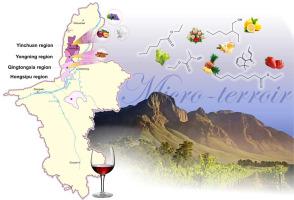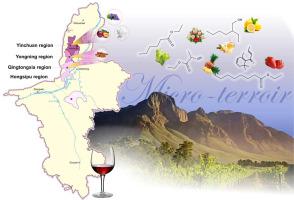Unveiling sub-regional aroma differences in China's Ningxia region: Characterization of key aroma profiles and chemical foundations via sensomics and RATA
IF 9.8
1区 农林科学
Q1 CHEMISTRY, APPLIED
引用次数: 0
Abstract
Sub-regional characteristic differentiation is crucial for development of wine regions, particularly for emerging regions. This study aims to identify and quantify the key aroma-active compounds and to analyze the aroma characteristics in Marselan wines from different Ningxia sub-regions using sensomics methods and the rate-all-that-apply approach. By employing GC × GC-qTOFMS and GC-O, we comparatively evaluated the contributions of the aroma-active compounds from four sub-regions. Fifty-three aroma-active compounds were identified. Seven compounds were important contributors to the fruity aroma. The omission experiments further confirmed the important contribution of ethyl hexanoate and β-damascenone to the floral and fruity characters. Yinchuan was characterized by its floral and fruity notes and methyl octanoate and ethyl octanoate were the main contributors. Qingtongxia and Yongning were characterized by Sweet spice, driven by nonanal and 4-methyl-1-pentanol. The differences in aroma profiles and the chemical basis across the sub-regions of Ningxia provide compelling evidence reinforcing the intra-regional micro-terroir.


揭示中国宁夏地区的分区域香气差异:基于感体学和RATA的关键香气特征和化学基础特征
次区域特色差异化是葡萄酒产区,尤其是新兴产区发展的关键。本研究旨在利用感官学方法和全效率方法,对宁夏不同产区马塞兰葡萄酒的主要香气活性物质进行鉴定和定量,并分析其香气特征。采用GC- × GC- qtofms和GC- o对比评价了4个子区域的芳香活性化合物的贡献。共鉴定出53种芳香活性化合物。7种化合物是水果香气的重要贡献者。遗漏实验进一步证实了己酸乙酯和β-大马士革酮对花果性状的重要贡献。银川以花香和果香为主,辛酸甲酯和辛酸乙酯为主要成分。青铜峡和永宁以壬醛和4-甲基-1-戊醇为主要原料,具有较强的甜味。宁夏各子区域间香气特征和化学基础的差异为加强区域内微风土提供了强有力的证据。
本文章由计算机程序翻译,如有差异,请以英文原文为准。
求助全文
约1分钟内获得全文
求助全文
来源期刊

Food Chemistry
工程技术-食品科技
CiteScore
16.30
自引率
10.20%
发文量
3130
审稿时长
122 days
期刊介绍:
Food Chemistry publishes original research papers dealing with the advancement of the chemistry and biochemistry of foods or the analytical methods/ approach used. All papers should focus on the novelty of the research carried out.
 求助内容:
求助内容: 应助结果提醒方式:
应助结果提醒方式:


